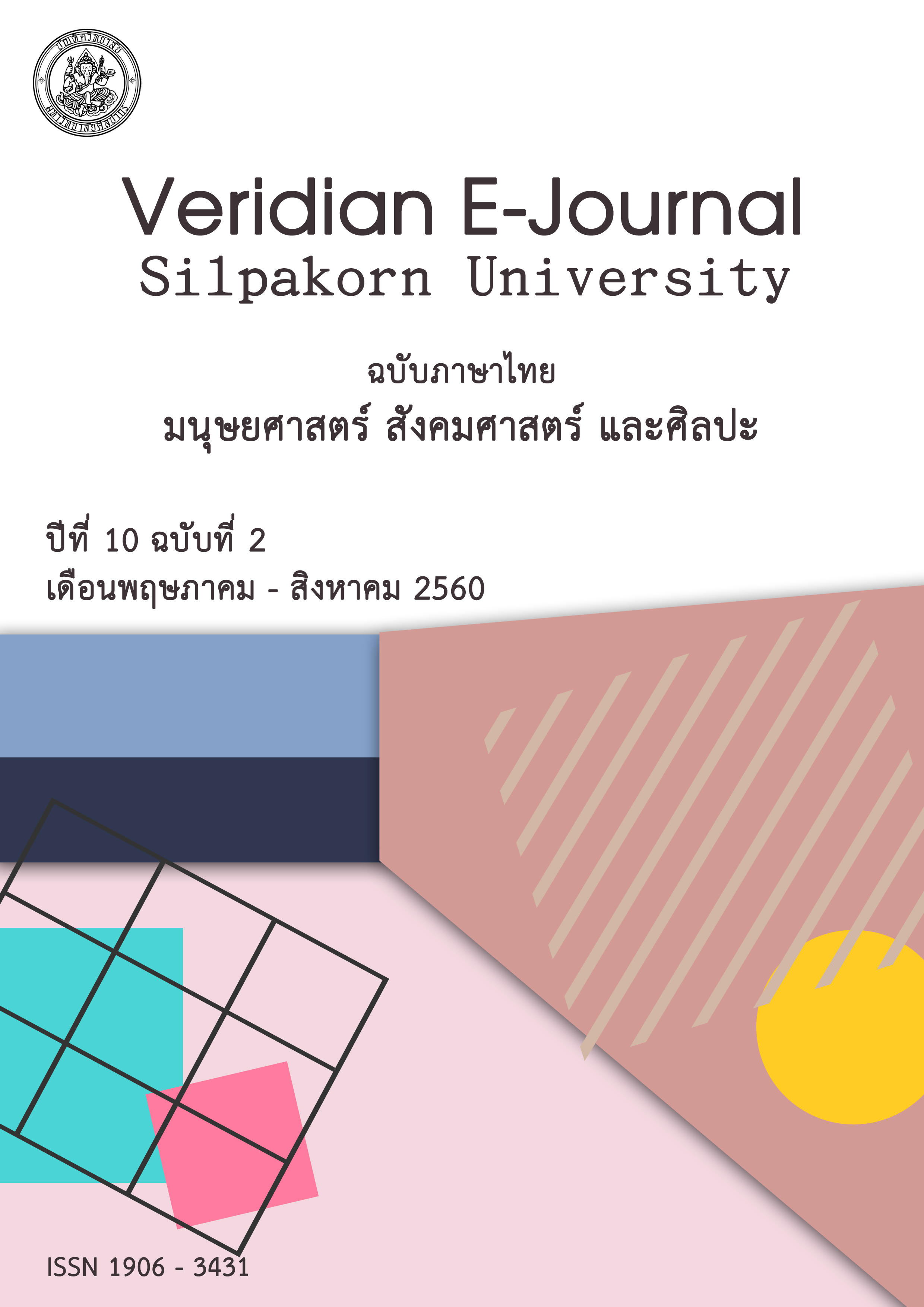สภาพแวดล้อมและระบบการทำนาแห้วของเกษตรกร จังหวัดสุพรรณบุรี
Main Article Content
บทคัดย่อ
การวิจัยครั้งนี้มีวัตถุประสงค์เพื่อศึกษาสภาพแวดล้อมการทำนาแห้วของเกษตรกรผู้ปลูกแห้ว และศึกษาระบบการทำนาแห้วของเกษตรกรผู้ปลูกแห้ว โดยเลือกพื้นที่ศึกษาตำบลวังยาง อำเภอศรีประจันต์ จังหวัดสุพรรณบุรี เพื่อเป็นประโยชน์แก่เกษตรกรนำไปวางแผนพัฒนาปรุงการดำเนินงานทำนาแห้วเพื่อลดจุดอ่อนและอุปสรรคของการทำนาแห้ว และใช้โอกาสในการเพิ่มขีดความสามารถในการทำนาแห้วต่อไป ดำเนินการศึกษาโดยใช้ระเบียบวิธีวิจัยเชิงคุณภาพ (Qualitative Research) เก็บรวบรวมข้อมูลจากการศึกษาเอกสารและการสัมภาษณ์เชิงลึกกลุ่มผู้ให้ข้อมูลหลัก 2 กลุ่ม คือ เจ้าหน้าที่สำนักงานส่งเสริมการเกษตร ประกอบด้วย เกษตรอำเภอศรีประจันต์ เกษตรตำบลวังยาง และนักวิชาการส่งเสริมการเกษตร สังกัดสำนักงานส่งเสริมการเกษตรอำเภอศรีประจันต์ และเกษตรกรผู้ปลูกแห้วที่มีพื้นที่ปลูกและภูมิลำเนาอาศัยในตำบลวังยาง อำเภอศรีประจันต์ จังหวัดสุพรรณบุรี รวมจำนวน 13 คน
ผลการศึกษาสภาพแวดล้อมการทำนาแห้วของเกษตรกรผู้ปลูกแห้ว พบว่า สภาพแวดล้อมภายในด้าน เกษตรกร ด้านสายพันธุ์แห้ว ด้านเงินลงทุน ด้านเครื่องมือในการผลิต และด้านการบริหารจัดการ นับเป็นจุดแข็งหรือข้อได้เปรียบของการปลูกแห้วในจังหวัดสุพรรณบุรี และเมื่อวิเคราะห์สภาพแวดล้อมภายนอกของการทำนาแห้ว ในจังหวัดสุพรรณบุรี พบว่า อุปสรรคของการทำนาแห้ว ได้แก่ การตั้งถิ่นฐานและขยายตัวของพื้นที่ชุมชนและการเพิ่มขึ้นของต้นทุนการผลิต ส่วนโอกาสของการทำนาแห้ว ได้แก่ การพัฒนาเครื่องมืออุปกรณ์ที่ช่วยเพิ่มประสิทธิภาพ การผลิต ความเหมาะสมของที่ตั้งทางภูมิศาสตร์และทรัพยากรธรรมชาติ ส่วนผลการศึกษาระบบการผลิตแห้วประกอบด้วย 3 องค์ประกอบ คือ 1) ปัจจัยนำเข้า ได้แก่ เกษตรกร วัตถุดิบการผลิต เงินทุน เครื่องมือและการบริหาร จัดการ 2) กระบวนการปลูก มี 4 ขั้นตอน ได้แก่ การเพาะกล้าพันธุ์แห้ว การปลูก การดูแลรักษาและการเก็บเกี่ยว และ 3) ปัจจัยนำออก ได้แก่ ปริมาณและคุณภาพแห้วอยู่ที่ประมาณ 3,500 - 4,500 กิโลกรัมต่อไร่ หรือประมาณ 250 - 300 ถังต่อไร่ ทั้งนี้ขึ้นอยู่กับความเหมาะสมของสภาพน้ำและอากาศ ราคาแห้ว ต้นฤดู (เดือนตุลาคม) กิโลกรัมละ 13 - 15 บาท หรือถังละ 200 บาท ส่วนปลายฤดู (เดือนธันวาคม) กิโลกรัมละ 16 - 18 บาท หรือถังละ 260 - 300 บาท ช่องทางการจำหน่ายมี 2 แบบคือ จำหน่ายแห้วสดแบบไม่ปอกเปลือกและแห้วสดแบบปอกเปลือก และการส่งเสริมการขายในลักษณะที่ภาครัฐไม่ได้เข้ามากำหนดราคา ควบคุมราคา ส่งเสริมหรือสนับสนุนโดยตรง
The purposes of this research are to investigate the environment of water chestnut and to study the farming system of water chestnut farmers. The research site is in Tambon Wang Yang, Sri Prachan district, Suphanburi Province. This study is benefit to the farmers, who plan to develop the operation of chestnut in order to reduce the weaknesses and obstacles of farming, including taking the opportunity to increase the capacity in the future. The study is conducted using qualitative research. Data are collected from document study and in-depth interviews with two groups of main informants: 1) the officers in Department of Agriculture Extension (Extension officer, Chief and of Subject Matter Specialist in Sri Prachan District Agricultural Extension Office), 2) and the water chestnut growers whose farming and their houses are in Tambon Wang Yang, Si Prachan District, Suphanburi Province, totally 13 participants.
The results of the study on the water chestnut farming environment are found that the internal environment of farmers, water chestnut lineage, investment, production tools and management are the strength or advantage of the water chestnut farming in Suphanburi. While the external environments are analyzed and are found that the threats of water chestnut farming are settlement and expansion of community areas and the increase in production costs, whereas the opportunities for farming are the development of equipment that improves production efficiency, the appropriateness of geographic location and natural resources. In addition, the results of the study on the production system of water chestnut farming are consisted of 3 components: 1) inputs: farmers, raw materials, capital, tools and management; 2) planting processes which are consisted of 4 stages, they are breeding, planting, treatment and harvesting, 3) Output factors include quantity and quality of water chestnut at approximately 3,500 - 4,500 kg / rai or approximately 250 - 300 barrels / rai, which is depending on the suitability of water and climate. The price of the water chestnut in early season (October), is 13 - 15 baht per kilogram or 200 baht per tank and at the end of the season (December), 16 - 18 baht per kilogram or 260 - 300 baht per tank. There are 2 types of distribution channels which are fresh with no peeling and fresh chestnut with peel. For the promotion, the government does not set prices, control prices, promote or support directly.

